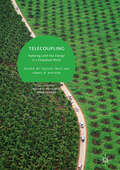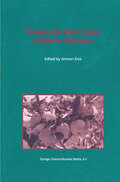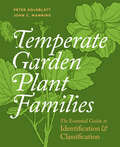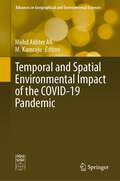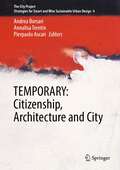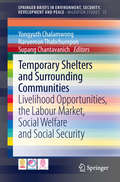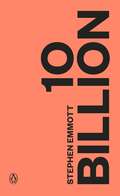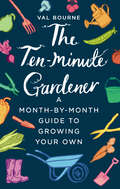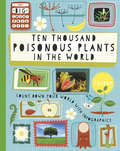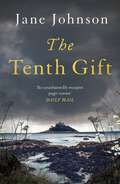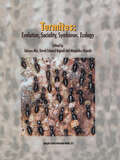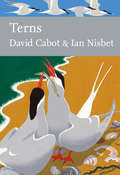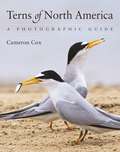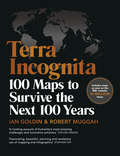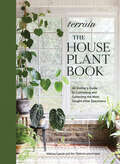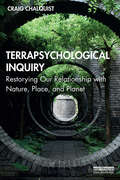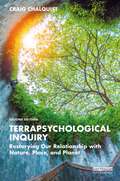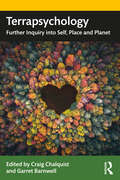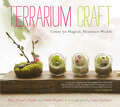- Table View
- List View
Telecoupling: Exploring Land-Use Change in a Globalised World (Palgrave Studies in Natural Resource Management)
by Jonas Ø. Nielsen Cecilie FriisThis book presents a comprehensive exploration of the emerging concept and framework of telecoupling and how it can help create a better understanding of land-use change in a globalised world. Land-use change is increasingly characterised by a spatial disconnect between its main environmental, socioeconomic and political drivers and the main impacts and outcomes of those changes. The authors examine how this separation of the production and consumption of land-based resources is driven by population growth, urbanisation, climate change, and biodiversity and carbon conservation efforts. Identifying and fostering more sustainable, just and equitable modes of land use and intervening in unsustainable ones thus constitute substantial, almost overwhelming challenges for science and policy. This book brings together leading scholars on land-use change and sustainability to systematically discuss the relevance of telecoupling research in addressing these challenges. The book presents an overview of the telecoupling approach, reflects on a number of the most pressing issues surrounding land-use change today and discusses the agenda for advancing understanding on sustainable land-use change through interdisciplinary and transdisciplinary research.
Temperate Fruit Crops in Warm Climates
by A. ErezAs a member of the working group (WG) on "Temperate Zone Fruit Trees in the Tropics and Subtropics" of the International Society for Horticulture, I was aware of the lack of readily available information needed in many warm-climate locations where temperate fruit crops are grown. The founder of this WG, Frank Dennis, Jr. , was motivated to encourage knowledge transfer by sharing knowledge with many developing countries. We shared his drive and in presenting this book we believe we are doing a service to all persons interested in temperate fruits, but especially to those in tropical and subtropical countries, many of which are developing countries interested in growing these crops and lacking the knowledge needed. In this book, we have collected information covering a variety of different aspects of growing temperate fruit crops in warm climates. As this is the first time such an evaluation of these species has been done, interesting and novel aspects of tree development and fruiting are presented, with stress on elements like dormancy and irrigation that are not of such basic concern in the natural of the temperate zones. We are living in a transition age; horticultural studies habitat are changing and expertise such as can be found in the array of participants in this book is probably not going to be easily found in the future. I hope that this book will broaden our understanding of the fruiting Temperate Zone tree in general and of its adaptation to warm climates, in particular.
Temperate Garden Plant Families: The Essential Guide to Identification and Classification
by Peter Goldblatt John C. ManningThe first comprehensive identification guide to include new classifications based on DNA analysis, this resource helps readers identify the 140 most important temperate plant families.
Temporal and Spatial Environmental Impact of the COVID-19 Pandemic (Advances in Geographical and Environmental Sciences)
by Mohd Akhter Ali M. KamrajuThis book identifies, evaluates and reports the impacts of the COVID-19 pandemic on the physical, biological and socioeconomic environment, using the science and technology of geoinformatics. It encourages the environmental considerations in the future city and policy planning and decision-making. For example, according to the World Health Organization, 80% of people living in cities are exposed to polluted air that exceeds healthy levels. City planners have applied the developing concepts of sustainability to modern debates over how cities and regions should be reviewed, regenerated and reformed since the introduction of the concept in developmental science. During the COVID-19 pandemic, a remarkable drop in air pollution has been observed in India and other countries, which has accelerated the shift to green and sustainable development. Geoinformatics can provide solutions and resources for local, sustainable activities in education, health, sustainable agriculture, resource management and related fields. This book serves researchers in a variety of areas, including hazards, land surveys, remote sensing, cartography, geophysics, geology, natural resources, environment and geography.
TEMPORARY: Citizenship, Architecture and City (The City Project #4)
by Andrea Borsari Annalisa Trentin Pierpaolo AscariThis book offers a comprehensive overview of forces shaping urban renewal and the sustainable and inclusive transformation of contemporary cities. It discusses temporariness and uncertainty of citizenship, participation, and inclusion, as well as the energy and digital transformation, merging different perspectives, such as the social, philosophical, economic, and architectural ones. Based on revised and extended contributions to the International Congress “TEMPORARY: Citizenship, Architecture and City", held virtually on November 20-21, 2022, from the University of Bologna, this book offers extensive information and a thought-provoking reading to researchers in architecture, anthropology, social and environmental policy, as well as to professionals and policy makers involved in planning the city of the future.
Temporary Shelters and Surrounding Communities: Livelihood Opportunities, the Labour Market, Social Welfare and Social Security (SpringerBriefs in Environment, Security, Development and Peace #15)
by Yongyuth Chalamwong Naruemon Thabchumpon Supang ChantavanichThis book is one of four volumes on a major empirical migration study by leading Thai migration specialists from Chulalongkorn University (Bangkok) for the United Nations Development Programme (UNDP).This volume reviews the livelihood opportunities for displaced persons in temporary shelters and in the surrounding communities. It explores labor-market conditions and provides recommendations for improving opportunities. The editors discuss the current policies of the Royal Thai Government towards displaced persons on restrictions for settlement that impede access to welfare, justice, education and health care. Service provision for displaced persons are identified here, as well as access to justice and other key services, including Thai services outside the settlements, and the potential for conflict with the local Thai population over resource allocation. Summarizing the results of a highly important research project this volume provides realistic policy recommendations for a durable solution for refugees at the borders. Policymakers from governments, international organizations and NGOs will benefit from its findings and conclusions.
Ten Billion
by Stephen Emmott'I think we're fucked' Stephen EmmottTen Billion is a book about us.It's a book about you, your children, your parents, your friends. It's about every one of us. It's about our failure: failure as individuals, the failure of business, and the failure of our politicians.It is about an unprecedented planetary emergency.It's about the future of us.
The Ten-Minute Gardener: A month-by-month guide to growing your own (Ten-minute Gardener Ser.)
by Val BourneTHE PERFECT GIFT FOR GARDENERSWhether you have a spacious plot or a small patch in the garden, this handbook is full of tried-and-tested tips from a seasoned old hand. It offers practical month-by-month suggestions for making the most of the little time you can spare on both the coldest winter days and the long summer afternoons, with ideas to inspire even the most experienced allotment gardeners. Focusing on the essentials needed to produce a great crop, this is for those who want to but struggle to find the time to grow their own.For those who garden in snatched moments . . . *Combined and updated editions of The Ten Minute Gardener's Fruit-Growing Diary and The Ten Minute Gardener's Vegetable-Growing Diary*
Ten Stories (Pan 70th Anniversary #8)
by Rudyard KiplingA special edition of Ten Stories by Rudyard Kipling reissued with a bright retro design to celebrate Pan’s 70th anniversary. This selection of Rudyard Kipling’s short stories features ten of his most brilliant creations – a thrilling mix of mysteries, adventures, science fiction and horror. In these tales of shipwrecks and tidal waves, blackmailers and false kings, hallucinating poets and shell-shocked gardeners, Kipling uses the full force of his creative powers to devastating effect. An entertaining collection from the much loved author of The Jungle Book, and the first book ever published as a Pan paperback.
Ten Thousand Poisonous Plants in the World (The Big Countdown #6)
by Paul RockettYou can count numbers all around you, from the eight legs on a spider to the one nose on your face. But can you count the stars in the sky or the fish in the Amazon? Find out all about PLANTS in THE BIG COUNTDOWN, including the many different types and species, photosynthesis, flowers, pollination and seeds, how plants grow and how we depend on plants for food and many other products. Discover some amazing facts from the tallest tree to the most poisonous seeds.The Big Countdown looks at popular topics and investigates the great many numbers that make them fascinating. From the mind-bogglingly large to smallest and most precious, this series helps us understand that it's not just our days that are numbered.
The Tenth Gift
by Jane Johnson'An unashamedly escapist page-turner' Daily MailIn an exclusive London restaurant, Julia Lovat is given a gift that will change her life. The antique book of Jacobean embroidery delights her, but when she looks more closely, she discovers within its faded pages the extraordinary diary of a young Cornish girl, calling to her from across the centuries.On a Sunday morning in July 1625, Barbary pirates sail into a quiet Cornish bay and storm the church. Their loot: sixty men, women and children, bound for northern Morocco where they will be sold as slaves. Amongst them is Cat Tregenna, a talented young embroiderer. But as her diary reveals, Cat is anything but the compliant slave her captors were expecting...Praise for The Tenth Gift: 'An engrossing romance of clashing cultures and wonderful characters' Diana Gabaldon'Beautifully written, first-class escapism' Mail on Sunday'Revivifies the guilty pleasure of historical romance' Independent
Termites and heritage buildings: A study in integrated pest management
by Brian RidoutThe last overview of termites for the non-specialist was published several decades ago and in the intervening years, both knowledge, and the termites themselves have moved on. A 27-year eradication effort for one termite infestation in Devon has shown that UK structures are becoming vulnerable as the climate changes and also that extermination of a colony can be difficult even when there are no other termites waiting to invade. Heritage buildings often present even more problems. Survey work and treatments may be complicated by structural and material complexity overlain with a requirement to retain as much undisturbed and original fabric as possible. There will be concealed cavities not inspected, and inserted barriers, both chemical and physical, will inevitably be incomplete. This study discusses the modifiable environmental parameters that govern termite activity and offers a resume of the baits and chemical treatments that have been developed so that the most appropriate can be selected where necessary. It is primarily intended for those involved in conservation, both in the UK and elsewhere, who commonly have limited resources. It is hoped that it will also be of use to architects, surveyors and others with an interest in Heritage structures.
Termites: Evolution, Sociality, Symbioses, Ecology
by Y. Abe David Edward Bignell T. HigashiThe book is a new compendium in which leading termite scientists review the advances of the last 30 years in our understanding of phylogeny, fossil records, relationships with cockroaches, social evolution, nesting, behaviour, mutualisms with archaea, protists, bacteria and fungi, nutrition, energy metabolism,population and community ecology, soil conditioning, greenhouse gas production and pest status.
Terns (Collins New Naturalist Library #123)
by David Cabot Ian NisbetThis New Naturalist volume provides a much-anticipated overview of these fascinating birds – the first book on the natural history of British and Irish terns since 1934.
Terns of North America: A Photographic Guide
by Cameron CoxA full-color photographic guide to these captivating and challenging birdsThis is the essential identification guide to the terns, noddies, and skimmers of North America. Covering every species and featuring hundreds of high-quality color images, this book is the ideal companion for anyone interested in this charismatic but sometimes challenging group of seabirds. Detailed species accounts describe the size of each bird as it appears in the field along with structure, behavior, flight style, vocalizations, subspecies, and North American and worldwide ranges. An incisive introduction lays out a remarkably simple approach to identification that focuses on key elements and addresses how to avoid getting bogged down in the variability of appearance. This state-of-the-art guide also provides additional in-depth coverage of the two most challenging groups of terns, Sterna terns and crested terns, aiding field identification while also highlighting the beauty and elegance of these marvelous seabirds.Features more than 325 stunning color photos, with side-by-side comparisons of similar species throughoutIncludes detailed captions for each image that describe age and key identification traitsCovers 19 species found in North America, including the most frequent vagrantsPresents a unique, simplified approach to field identificationExplains the fundamentals of molts, plumages, and hybridizationProvides in-depth coverage of Sterna terns and crested terns
Terns of North America: A Photographic Guide
by Cameron CoxA full-color photographic guide to these captivating and challenging birdsThis is the essential identification guide to the terns, noddies, and skimmers of North America. Covering every species and featuring hundreds of high-quality color images, this book is the ideal companion for anyone interested in this charismatic but sometimes challenging group of seabirds. Detailed species accounts describe the size of each bird as it appears in the field along with structure, behavior, flight style, vocalizations, subspecies, and North American and worldwide ranges. An incisive introduction lays out a remarkably simple approach to identification that focuses on key elements and addresses how to avoid getting bogged down in the variability of appearance. This state-of-the-art guide also provides additional in-depth coverage of the two most challenging groups of terns, Sterna terns and crested terns, aiding field identification while also highlighting the beauty and elegance of these marvelous seabirds.Features more than 325 stunning color photos, with side-by-side comparisons of similar species throughoutIncludes detailed captions for each image that describe age and key identification traitsCovers 19 species found in North America, including the most frequent vagrantsPresents a unique, simplified approach to field identificationExplains the fundamentals of molts, plumages, and hybridizationProvides in-depth coverage of Sterna terns and crested terns
Terra Incognita: 100 Maps to Survive the Next 100 Years
by Ian Goldin Robert Muggah'Amazing. It would be my desert island choice' Martin Rees'Fascinating, beautiful, alarming and revelatory use of mapping and infographics' Stephen Fry on EarthTime maps'An indispensable read' Arianna Huffington From the global impact of the Coronavirus to exploring the vast spread of the Australian bushfires, join authors Ian Goldin and Robert Muggah as they trace the ways in which our world has changed and the ways in which it will continue to change over the next hundred years. Map-making is an ancient impulse. From the moment homo sapiens learnt to communicate we have used them to make sense of our surroundings. But as Albert Einstein once said, 'you can't use old maps to explore a new world.' And now, when the world is changing faster than ever before, our old maps are no longer fit for purpose.Welcome to Terra Incognita. Based on decades of research, and combining mesmerising, state-of-the-art satellite maps with enlightening and passionately argued analysis, Ian and Robert chart humanity's impact on the planet, and the ways in which we can make a real impact to save it, and to thrive as a species.Learn about: fires in the arctic; the impact of sea level rise on cities around the world; the truth about immigration - and why fears in the West are a myth; the counter-intuitive future of population rise; the miracles of health and education that are waiting around the corner, and the reality about inequality, and how we end it. The book traces the paths of peoples, cities, wars, climates and technologies, all on a global scale. Full of facts that will confound you, inform you, and ultimately empower you, Terra Incognita guides readers to a new place of understanding, rather than to a physical location.
Terrain: An Insider's Guide to Cultivating and Collecting the Most Sought-After Specimens
by Melissa Lowrie&“An informative and inspiring guide to collecting and growing plants at home.&”—Gardenista &“This book is a must-have!&”—Hilton Carter, author of Wild at Home, Wild Interiors, and Wild CreationsSecrets of the Houseplant Hunters Terrain&’s plant experts travel the world in search of the most unusual and interesting houseplants. In this inspiring and practical guide, they share their favorite specimens: exotic and eclectic ferns, like the skeleton fork, a primitive (and unfussy) predecessor to the family; new aroids to feed that monstera obsession; and adventurous trailing plants like dischidia, which is found cascading from tree branches in its native Thailand; plus succulents and cacti, indoor trees, the best low-care plants, and &“rule breakers&” like bamboo muhly grass that can make an unexpected move indoors. Along the way, Terrain introduces their favorite independent growers—passionate plant lovers who are creating new hybrids and bringing back old-school specimens to the market. And readers learn Terrain&’s way of styling and overarching philosophy on care: the most important thing we can give our plants is our presence.
Terrapsychological Inquiry: Restorying Our Relationship with Nature, Place, and Planet
by Craig ChalquistTerrapsychological Inquiry is a qualitative research methodology seeking a form of inquiry that takes seriously our intense inner responses to the state of the natural world. Terrapsychology is a theory and practice approach that studies, from the standpoint of lived experience, how the world gets into the heart. Oceans and skies, trees and hills, rivers and soils, and even built things like houses, cities, ports, and planes: How do they show up for us inwardly? How do our moods, feelings, and dreams reflect what happens in the world? Terrapsychological Inquiry evolved over a decade of experimentation by graduate students, instructors, workshop leaders and presenters, and other embodied creatives to offer a truly Earth-honoring mode of story-based qualitative inquiry, one that changes all involved from passive spectators of the doings of the world into active, sensitive participants. Learn how to use this methodology of reenchantment in a variety of settings inside and outside academia, and by doing so reenter an animate world. Written in an engaging and accessible style, this introduction to a new research methodology will be of great interest to students and scholars of environmental psychology, ecotherapy, and environment and sustainability studies more generally.
Terrapsychological Inquiry: Restorying Our Relationship with Nature, Place, and Planet
by Craig ChalquistTerrapsychological Inquiry is a qualitative research methodology seeking a form of inquiry that takes seriously our intense inner responses to the state of the natural world. Terrapsychology is a theory and practice approach that studies, from the standpoint of lived experience, how the world gets into the heart. Oceans and skies, trees and hills, rivers and soils, and even built things like houses, cities, ports, and planes: How do they show up for us inwardly? How do our moods, feelings, and dreams reflect what happens in the world? Terrapsychological Inquiry evolved over a decade of experimentation by graduate students, instructors, workshop leaders and presenters, and other embodied creatives to offer a truly Earth-honoring mode of story-based qualitative inquiry, one that changes all involved from passive spectators of the doings of the world into active, sensitive participants. Learn how to use this methodology of reenchantment in a variety of settings inside and outside academia, and by doing so reenter an animate world. Written in an engaging and accessible style, this introduction to a new research methodology will be of great interest to students and scholars of environmental psychology, ecotherapy, and environment and sustainability studies more generally.
Terrapsychological Inquiry: Restorying Our Relationship with Nature, Place, and Planet
by Craig ChalquistTerrapsychological Inquiry is a path of storied, imaginative research that takes seriously our intense inner responses to the state of the natural world. This place-rooted approach studies, from the standpoint of lived experience, how the world gets into the heart. Oceans and skies, trees and hills, rivers and soils, and even built things like houses, cities, ports, and planes: How do they show up for us inwardly? How do our moods, feelings, and dreams reflect what happens in the world? Terrapsychological Inquiry evolved over a decade of exploration by graduate students, instructors, ceremonialists, workshop leaders and presenters, and other practitioners of embodied creativity to offer an Earth-honoring mode of storied qualitative inquiry, one that transforms all involved from passive spectators of the doings of the world into active, sensitive participants. Learn how to use this methodology of earthly reenchantment in a variety of settings inside and outside academia and by doing so reenter an animate world. This new edition has been revised throughout and offers fresh insights into how Terrapsychological Inquiry, a field with roots in depth psychology, ecopsychology, and Hermetic philosophy, can also be used as an ecospiritual path. Thoroughly updated with a new chapter and added discussion questions and exercises at the end of each chapter, this introduction to an evolving research methodology will be of great interest to students and scholars of environmental psychology, ecotherapy, and environment and sustainability studies more generally.
Terrapsychological Inquiry: Restorying Our Relationship with Nature, Place, and Planet
by Craig ChalquistTerrapsychological Inquiry is a path of storied, imaginative research that takes seriously our intense inner responses to the state of the natural world. This place-rooted approach studies, from the standpoint of lived experience, how the world gets into the heart. Oceans and skies, trees and hills, rivers and soils, and even built things like houses, cities, ports, and planes: How do they show up for us inwardly? How do our moods, feelings, and dreams reflect what happens in the world? Terrapsychological Inquiry evolved over a decade of exploration by graduate students, instructors, ceremonialists, workshop leaders and presenters, and other practitioners of embodied creativity to offer an Earth-honoring mode of storied qualitative inquiry, one that transforms all involved from passive spectators of the doings of the world into active, sensitive participants. Learn how to use this methodology of earthly reenchantment in a variety of settings inside and outside academia and by doing so reenter an animate world. This new edition has been revised throughout and offers fresh insights into how Terrapsychological Inquiry, a field with roots in depth psychology, ecopsychology, and Hermetic philosophy, can also be used as an ecospiritual path. Thoroughly updated with a new chapter and added discussion questions and exercises at the end of each chapter, this introduction to an evolving research methodology will be of great interest to students and scholars of environmental psychology, ecotherapy, and environment and sustainability studies more generally.
Terrapsychology: Further Inquiry into Self, Place and Planet
by Craig Chalquist Garret BarnwellReflecting on and exploring the connection between the environments in which we live and our moods, motivations and dreams, this insightful volume takes the growing field of terrapsychology into new and exciting directions. This book draws together a group of contemporary voices in terrapsychology to explore lived topics, such as ecotransference encountered with sacred place, alternative mapping and expressions of solidarities with sacred sites, place dreaming, locianalysis, trans-species encounters, deep genealogy, terraplomacy and Hermeticism. The chapters focus on praxis, demonstrating how each author’s relationship with the more-than-human world has been reenchanted, revealing, remembering and co-creating relationships and community for life to flourish. Co-edited by Craig Chalquist and Garret Barnwell this collection will interest scholars, students and practitioners across a range of fields, including analytical psychology, environment psychology, and cultural anthropology.
Terrapsychology: Further Inquiry into Self, Place and Planet
by Craig Chalquist Garret BarnwellReflecting on and exploring the connection between the environments in which we live and our moods, motivations and dreams, this insightful volume takes the growing field of terrapsychology into new and exciting directions. This book draws together a group of contemporary voices in terrapsychology to explore lived topics, such as ecotransference encountered with sacred place, alternative mapping and expressions of solidarities with sacred sites, place dreaming, locianalysis, trans-species encounters, deep genealogy, terraplomacy and Hermeticism. The chapters focus on praxis, demonstrating how each author’s relationship with the more-than-human world has been reenchanted, revealing, remembering and co-creating relationships and community for life to flourish. Co-edited by Craig Chalquist and Garret Barnwell this collection will interest scholars, students and practitioners across a range of fields, including analytical psychology, environment psychology, and cultural anthropology.
Terrarium Craft: Create 50 Magical, Miniature Worlds
by Amy Bryant Aiello Kate BryantIf you&’ve always wanted to have a bit of nature in your own home, without the worry and labor of a garden, this book will show you exactly how to create your own unique, enchanting world inside a terrarium.
